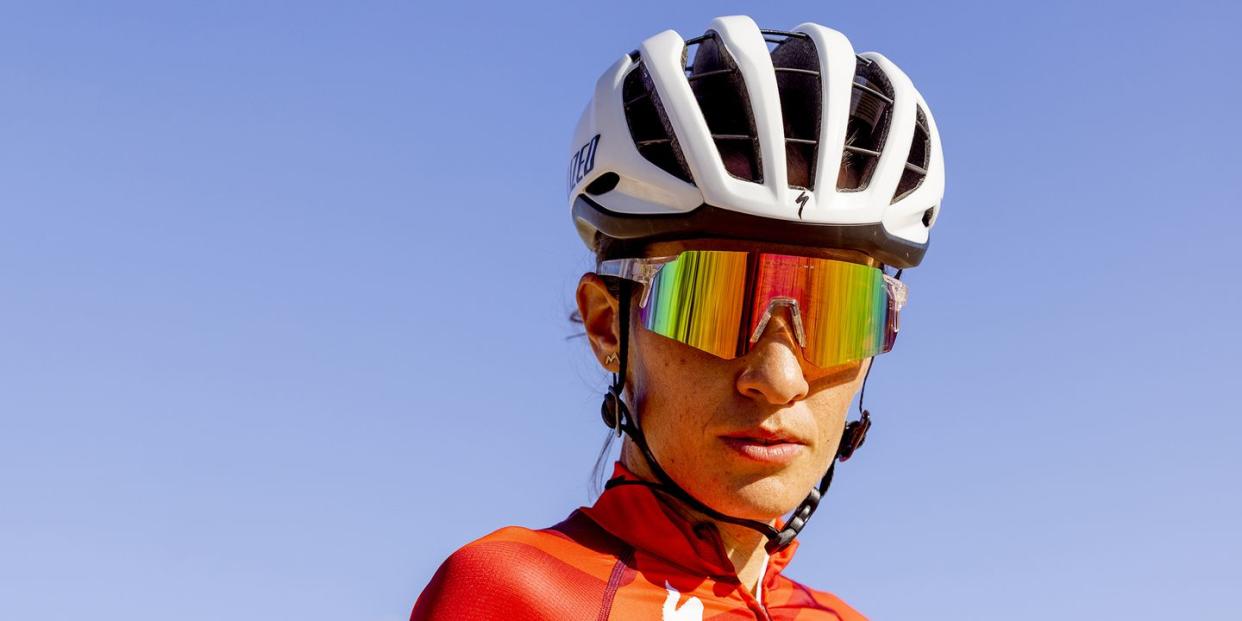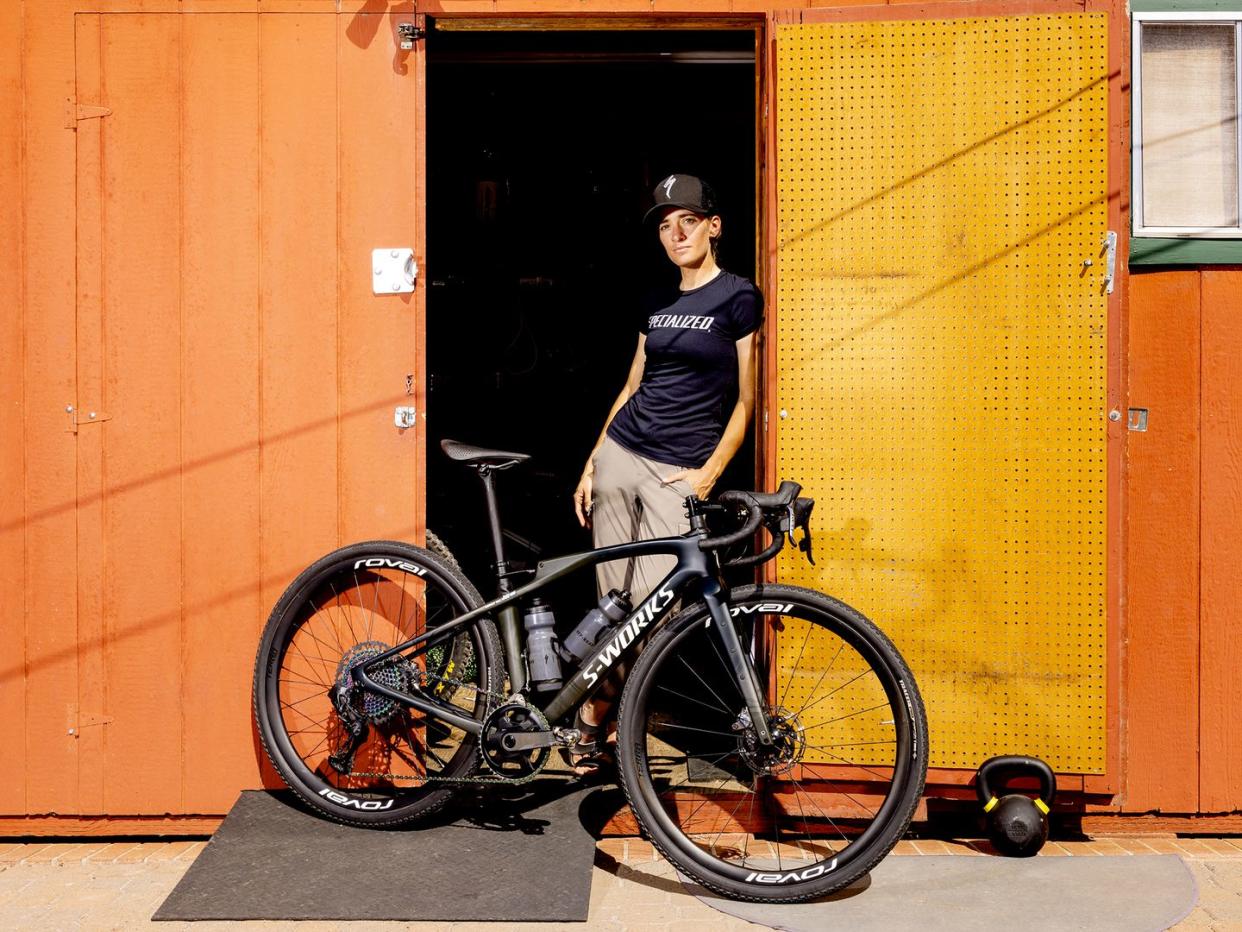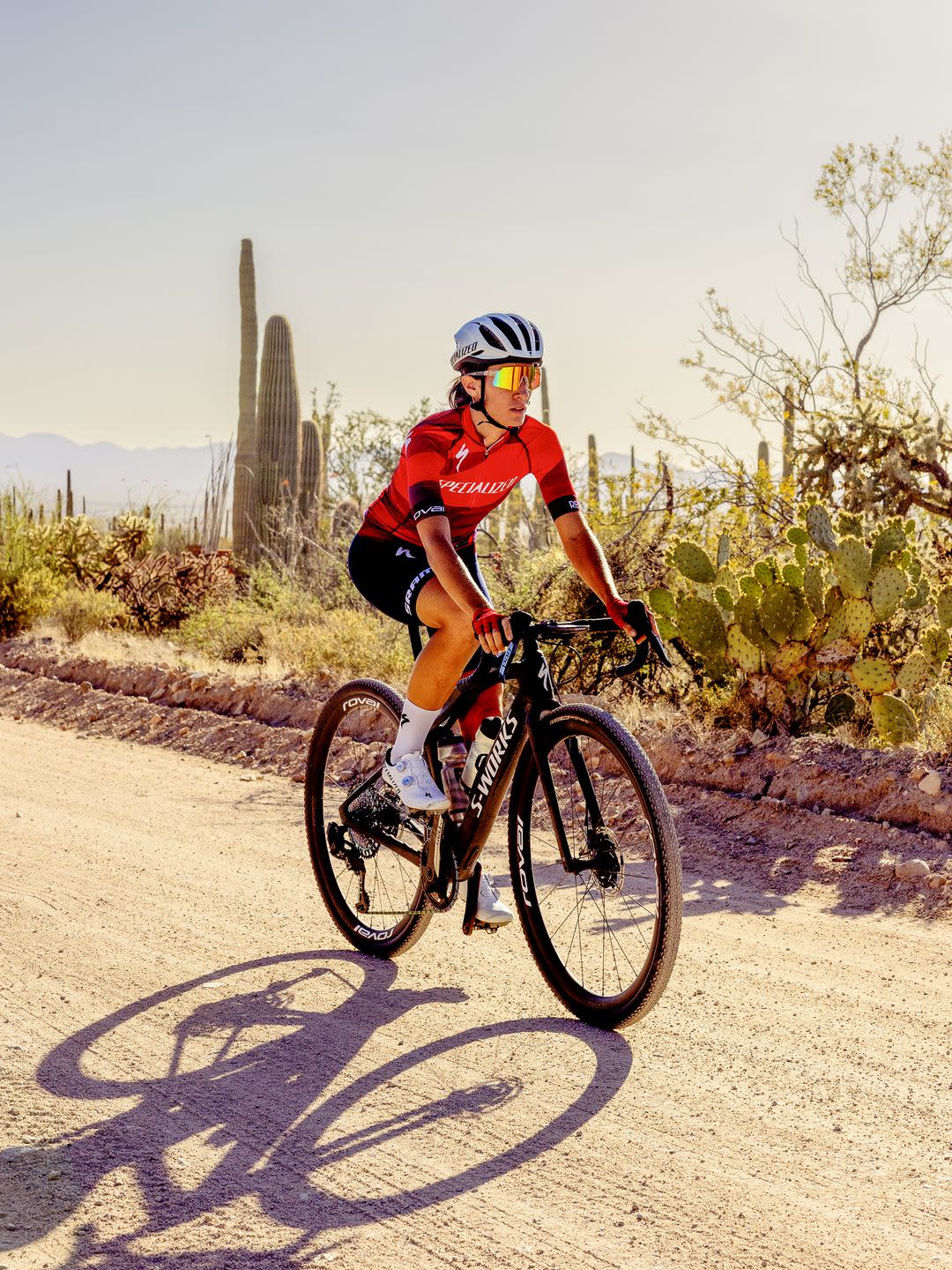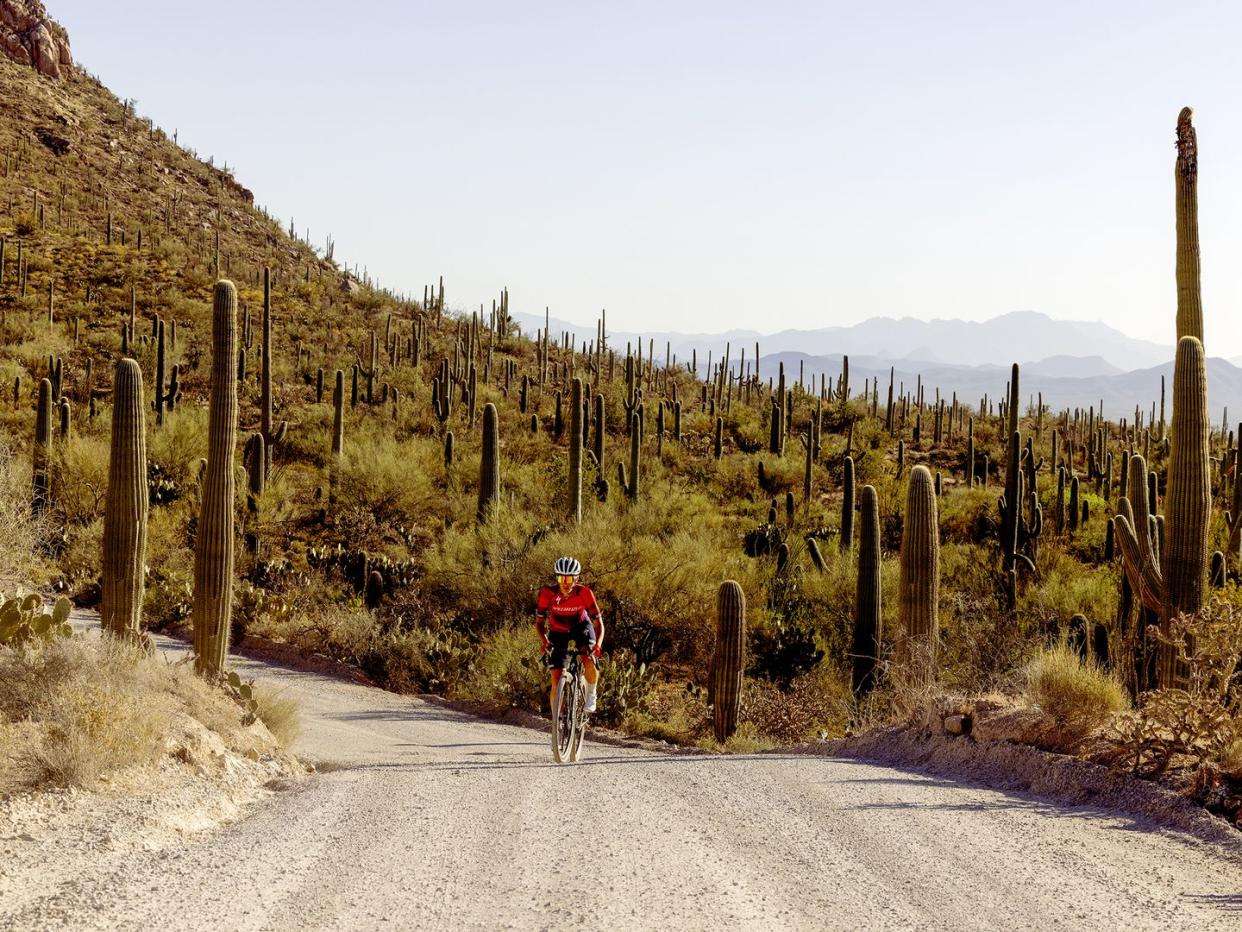How Sofia Gomez Villafañe Became a Gravel-Racing Superstar

The three leading women pedal the undulating hills of Fort Ord National Monument on California’s Monterey Bay, answering one another’s accelerations as they streamline in and out of chaparral clusters and oak woodlands. The group stretches and recoils as the riders dive into descents and negotiate the corners, dried-up ruts, loose rocks, and sand that could take them out of contention.
Fans edge the start-finish stretch of the 2022 Fuego 80K XC race at the Sea Otter Classic cycling festival in Laguna Seca Raceway, where the pro racers are soon to arrive after two laps of an old-school cross-country course. The race is the first in the inaugural Life Time Grand Prix series, six off-road courses—mountain bike and gravel—where 60 professional racers will battle it out for a $250,000 prize purse.
The Fuego course, which gains 5,700 feet of elevation with its short punchy climbs, is traditionally flowy, with a few blind turns, grassy mounds, and sand dunes that spill onto the tracks. It’s not a technical course—no drops, jumps, or rock gardens—but it is fast. There are only two sections where riders can attack: Hurl Hill, a steep half-mile stretch of singletrack; and Lookout Ridge, which is less steep, but at two and a half miles long, it can take up to 20 minutes (if you are in race shape) to complete before the last five-mile push to the finish line. The top women in this race ride it in 15 minutes or less.
Join Bicycling for unlimited access to best-in-class storytelling, exhaustive gear reviews, and expert training advice that will make you a better cyclist.
It’s now the riders’ last time over Lookout Ridge, its crest illuminated by an early April sun that reveals the trio slowing down as the grade kicks up again. The drone shot shows Alexis Skarda struggling to stay attached. And as the sun grows hotter, the rolling ribbon of dirt between Sofia Gomez Villafañe and Moriah Wilson in front of her gets longer. Already driving a hard pace, Sofia’s legs go silent to her demands.
Just two weeks earlier, Sofia had returned from South Africa atop a wave of confidence after a dominating performance at the Absa Cape Epic alongside her Specialized Factory Racing teammate, Haley Batten. The pair had won the general classification in the seven-day, 430-mile mountain bike stage race, putting 12 minutes between themselves and the second-place team—and more notably, a gap of 47 minutes to multi world champion Pauline Ferrand-Prévot and her teammate Robyn de Groot, riding then for BMC.
But this time she’s on her own, and she finishes 20 seconds behind Wilson. “That’s the last time I am giving up like that to a competitor,” Sofia says later to a rolling video camera, clothes changed and Specialized baseball cap on, lit in a dramatic confessional fashion. The recording would eventually appear in“Call of a Life Time,” the docuseries that followed a select group of riders, including Sofia, taking part in the Grand Prix.
The 29-year-old with dual Argentine and U.S. citizenship admits that self-doubt is her toughest competitor. “I want to race and know that I gave it 110 percent, and [only] quit when my legs are truly messed up, not when my mind is willing to give up.”
Over the next month of training in preparation for the Garmin Unbound Gravel race in early June, Sofia will run through scenarios in her head, visualizing anything that could happen come race time—and how she will respond to each challenge. She’ll picture herself repeatedly accelerating past the discomfort to close imaginary gaps.
Starting and finishing in Emporia, Kansas, and traversing the area’s infamous Flint Hills, Unbound is arguably the toughest race in the Life Time series. And at 200 miles, definitely the longest. It’s the first time Sofia will race that distance. And after some of the hundred-mile days her coach prescribes, she asks herself, “This is only half of Unbound… What have I gotten myself into?”

On race day, Sofia opts for a hydration pack, a saddle bag, a top-tube bag, and a set of aero bars on her 52cm Specialized Crux. Once in position, she rockets over the rutted, rubbly dirt that cuts through the Kansas prairie, her small frame hovering over the cockpit in prayer position against an ominous gray sky, shoulders relaxed, back flat.
Determined to shake off the disappointment of Sea Otter, Sofia wants to make a statement, but it’s a heavy burden. The weather doesn’t help: torrential rain, and eventually enough mud to force riders off their bikes for clumsy running; some lose shoes to the muck. She focuses on breaking the race into more manageable 50-mile blocks. With 80 miles left, Sofia leads the women’s race, clocking an almost 10-minute gap to 2021’s winner, Lauren De Crescenzo. (Moriah Wilson, who had been leading the Life Time series after her win at Sea Otter, had been tragically killed in May.)
As she crosses the finish line, she stretches her arms high above her head as if reaching for something no one else can see. Caked in mud, dust, and grit, she curtsies and bows to the crowd. Emporia’s new gravel queen has arrived.

“My day-to-day life is pretty dull,” Sofia says as she pulls the rear wheel of her S-Works Epic from her bike bag, the rainbow-grease iridescence of the SRAM Eagle cassette glinting in the sun. “When I’m not riding, I’m either prepping meals, stretching, walking the dog, or resting.”
It is the last day of March 2023 in Tucson, Arizona, where she shares a home with her partner, Keegan Swenson, and their dog, Wally, a chocolate Lab rescue. Their main home is in Heber City, Utah; Sofia bought the Tucson place in 2021 so they’d have somewhere to train over the winter. The suburban one-story is simple and comfortable; the decor gives off vibes of a modestly priced Airbnb. Outside, there is a shed, a wild and flourishing garden lining the adobe-wall fence, and a pergola with a set of chairs and a table. In her kitchen cabinets Sofia keeps a stash of samples from Ritual Chocolate, the Utah-based company where she works as an administrative manager.
Still jet-lagged after returning only a couple of days ago from another edition of Cape Epic, where she and Katerina Nash placed third, she has just finished lunch on the pergola after a morning training session on the road.
As one of the youngest kids in a household of eight, Sofia learned to care for herself early on. “I was always independent,” she says. She recalls fixing breakfast at 4 or 5 years old, stretching her arms high above her head, barely able to reach the kitchen counter. When her mom, Claudia, would come home from the weekly grocery run, Sofia would sneak into the kitchen to get first pick of the fresh fruit—not to enjoy right away, but to hide from her teenage siblings. “But then she would forget,” says her brother Julián Gómez Villafañe, with whom she is close. “You would grab a towel from the closet, and instead, you would find a banana or an orange rotting between the linens and wonder how it got there.”
The family had moved from Buenos Aires in 1983 to Esquel, a small Patagonian town in the northwest part of Argentina’s Chubut Province.“[Esquel] is very beautiful and very remote. We all grew up there,” says Julián. “Matías is the oldest; then comes Ana, and then me. With five years in between, then came Caro, immediately followed by Sofi, and as a surprise came Benjamín. Two sets of kids, 100 percent hermanos.”
Dad, Álvaro, worked as a veterinarian for the military and had a passion for fly fishing. Claudia, who came from a family of sailors and merchant marines with strong ties in the U.S., was the founder of Esquel’s only bilingual school, which she ran for 18 years. To accommodate the growing family, they made additions and changes to the house as each kid arrived. A formal dining room was added with a bedroom above it. Sofia shared a small room with her older sister Caro. “Bunk beds on the sides, like a little hallway. And then we had little desks and our closet. Our coat hangers had our names,” she says.

Esquel is surrounded by the snow-dusted peaks of La Zeta, La Cruz, and La Hoya—a majestic backdrop for a childhood of summers spent at lakes and rivers, of camping, fishing, and cooking outdoors over a fire. “Sometimes, when there was a bluebird skiing day, my dad would invite us to skip school and ski,” Sofia says. “Sometimes I would say no, because I loved school.”
Claudia says her daughter has always been a planner, a pragmatist. “She was very analytical too,” she adds, explaining that even during school recess, Sofia would be found standing on the sidelines observing the other kids. “She’s analyzing, ‘What’s going on here?’” Teachers would joke that they knew who their next principal would be.
But Esquel’s outdoorsy lifestyle couldn’t make up for the disadvantages of Argentina’s struggling economy and education system, and in 2005, when Sofia was 11, the family relocated to Los Gatos, California. Settling into their new life in the Bay Area wasn’t particularly easy or emotionally uncomplicated. Back in Esquel, she’d gone to a small school with fewer than 200 kids, and everyone knew everyone else. But her new school had three to four times as many students.
“I didn’t really fit in,” says Sofia. She tells the story of how in a geography lesson in a classroom full of well-off tech kids, the teacher had asked how many continents there were. Sofia raised her hand with the same good-student impulse she had back in Esquel, only to get the answer “wrong” while her classmates laughed. (Under the model taught in Argentina, North and South America are considered one continent.)
Undeterred, at least academically, Sofia made the honor roll by the first or second month in her new school. “She was very focused about trying to figure out how to do everything better,” says Álvaro. Part of that included trying to fit in. By the time Sofia was in high school, she was waking up early to fix her makeup and tame her naturally wavy hair with a flatiron before school. She would make a conscious effort to reel back the “voseo” and Neapolitan ring of her Argentine accent, trying to transform herself into someone she thought others would like. But at some point, she says, she stopped caring about pleasing people. “I just kind of woke up one day and said, ‘Fuck it. Like, these aren’t people that are going to be in my life for the rest of my life. I’m wasting my time. I could be sleeping more.”

After “Call of a Life Time” aired this winter, Sofia received a flurry of messages on social media from viewers who were put off by some of her comments in the docuseries, in which she said things like, “I haven’t been challenged in the way that I thought I would,” and, “I think I am the clear favorite.” Some went so far as to label her a “bitch.”
It’s hard to imagine anyone reacting negatively to that kind of confidence from a male competitor. “There’s a double standard on male versus female athletic professionals,” says Sofia. “When a man speaks with a high level of confidence it is praised, but when a woman says the exact same words, they are taken as the opposite.”
Sofia says she hasn’t watched the series but makes no apologies for her professional approach. “I think people were a bit shocked at the level of competitiveness and fearlessness that I bring and how I see [gravel racing] as a job rather than a lifestyle. I do treat it very professionally, and I’m very aware that I’m paid to win bike races and perform. I’m not being paid as a lifestyle athlete or to be an influencer,” she says.
Of the active siblings, older sister Caro had been the first to show a talent for mountain bike and cyclocross racing. But then 15-year-old Sofia, who’d been part of her sister’s entourage from race to race, voiced interest in giving it a try. According to Julián, Caro, in typical sibling fashion, made a remark that insinuated that Sofia “would probably not be very good at it.” Sofia bit her tongue and remained quiet, but gave her sister a look that said, You will see. And so an informal rivalry between the sisters was born. “I had that [rivalry] with Matías,” says Julián, who was in his early 20s at the time. “That type of challenge can be really motivating.”
Julián helped Sofia find her first mountain bike on eBay, an older Trek he got for about $400. At her first race, Sofia’s drive to prove her sister wrong was front and center. “I just went super hard. I won by four and a half minutes, and I was so pumped,” she says. Later she would work a part-time job at Trail Head Cyclery in San Jose, where she saved enough to upgrade her mountain bike.
It wasn’t long before Sofia joined the NorCal High School Mountain Bike League, all while continuing to make the honor roll and serving in the leadership group at her school. According to Claudia, she didn’t like how certain things were run in the league. “And so she gave some ideas to how to better organize the team,” she says. “She had some ideas on how to recruit, and they let her run with it.”

The friendly rivalry between the sisters continued as they began racing cyclocross. In her freshman year of college, Sofia and Caro would travel to ’cross races in Las Vegas and Los Angeles in addition to their Bay Area events. They also went on to represent Argentina in the 2016 Cyclocross World Championships in Belgium, where Caro raced in the Pro field and Sofia in the U23.
Like her dad, Sofia fancied the mountains and outdoorsy lifestyle. After graduation, she left Los Gatos for Fort Lewis College in Durango, Colorado. The location checked the boxes of topographical comfort, and she could not only pursue a sensible profession (exercise science with a minor in business administration) with the help of a small scholarship and a part-time job, but also ride with the collegiate cycling team for fun.
In Durango she met Keegan Swenson, an up-and-coming mountain bike racer from Utah. “At 17, Keegan had the discipline of a professional athlete,” says Julián, who considers Swenson family. During those years, she played the role of supportive girlfriend during Swenson’s journey to pro, a path she says she had never entertained for herself. “It’s never been my dream to be a bike racer,” she says.

It wasn’t until 2015 that Sofia began to imagine that there might be a loftier goal within her reach. During a midweek ’cross practice, she was approached by Carmen Small, the former U.S. time trial champion and member of two world championship TTT squads, who currently works as a directeur sportif for UCI Women’s WorldTeam Team Jumbo–Visma.
Small, who’d been watching Sofia consistently climb up the ranks at local events in Durango, boldly proclaimed: “I can make you an Olympian in four years.” At the time, Sofia was aiming to win collegiate ’cross nationals and not focusing on a pro career. “I most definitely did not see her vision, but I did really want to win collegiate cyclocross nationals,” she says. “I said yes and got to work, because if someone was going to donate their time to help me, I was not going to take that for granted.” (Small, in offering her services, told Sofia she wanted to pay forward all the help she’d received herself over the years.)
“When I first started training with Carmen, we had this big goal of going to the Olympics, but she was like, ‘We have to build you up and make sure we don’t cook you, because that’s what allows you to have a successful and long-term career.” Small delivered on her promises, and Sofia went on to compete in the 2021 Tokyo Olympics as the first woman since 2004 to represent Argentina in XC mountain biking. She finished 23rd in the XCO race where Switzerland’s Jolanda Neff took gold. (And, yes, she did win collegiate ’cross nationals back in 2015.)
That was also the year Sofia tried gravel racing for the first time, when she jumped into a few events to experience firsthand what all the fuss around the emerging off-road discipline was about. Her mountain bike and ’cross background served her well. On her first try, she won Utah’s Crusher in the Tushar and North Carolina’s Belgian Waffle Ride in Asheville. And after her decisive 2022 win at Unbound 200, she finished second to Haley Smith in the overall Life Time series standings.
“[Carmen] is the reason I am a professional cyclist. She invested a lot of time and resources into me, and nothing had strings attached.” And that investment has continued to pay dividends. “Sometimes I forget how good I am,” Sofia says. “I’m finally at the point where people see my name on the start list, and they’re like, ‘Oh, shit.’”

It may not be surprising that the self-reliant little girl who hid snacks and whose motivation to race grew out of sibling rivalry is now forthright about what her success means.
“I’m not a dreamer. Dreams are imaginary, I don’t have dreams,” Sofia says. “I have goals… a goal is achievable.” And her goals for her cycling career go beyond winning. “I definitely want to cause change and growth within the women’s peloton,” she says. “Not just be someone defined by her results, but somebody that did something meaningful, and it helped somebody along the way.” When she’s done racing, she says she’d would like to work with a women’s development team out of Argentina.

Just like her goals, the standards to which Sofia holds herself can scrape the clouds. Not only as a cyclist, but as an advocate and change maker too. She wants to be a role model to Julián’s kids, ages 15, 12, and 10. His eldest, Francisca, is already involved in NICA and even raced the JV Sea Otter Classic this April, where she got second place. Sofia knows that in a world where athletes are judged not only by their talent but also by their behavior, they have power, or at least the means to influence and cause change.
Still, she is a student—and a pragmatist—at heart, and always wants to know how she measures up to a new challenge, and what she needs to do to get there. In addition to Carmen Small, she works with Alan Murchison, a sports nutritionist and Michelin-star chef. For each workout in her Training Peaks schedule, Murchison puts together a detailed recipe for a meal to compliment her training. Generous amounts of turmeric for recovery. Coconut milk for the medium-chain triglycerides and fatty acids ahead of a big day. Hefty amounts of cinnamon to assist glucose in moving out of the bloodstream and into cells. The marginal efforts in her everyday life that she will later turn into gains.
As for 2023, she is aiming high. She is racing the Life Time series for a second time—in April, she avenged last year’s second place Sea Otter finish with a triumphant victory in the Fuego XL. And she is favored to win Unbound on June 3.
More significant to her, though, is chasing the rainbow stripes of the UCI Gravel World Championship in Italy this October. There she looks to dethrone Pauline Ferrand-Prévot. “I would rather win rainbow stripes over $25,000 of Life Time money, you know?” she says. “Having that jersey literally means you are the best in the world.”
Back in Tucson, outside the home she shares with Keegan and Wally, with the overflowing garden, the adobe fence, the pergola, and the secret stash of chocolate, she props the rear wheel against the table to reinstall the disc rotors. A hummingbird weaves in and out of the lush plantings; the dog reclines in a sunny spot. Sofia moves on to the front wheel, installs the rotor, and then mounts the frame onto a mechanic stand. She slips in the thru-axles, tightens them, and gives each wheel a little spin to check for rubbing. Her right hand sits on the shifter now, and she pushes the pedal with her left listening to the clicks and watching the derailleur nudge the chain from the bottom cog to the top. With a squeeze of the brake lever, she silences the soothing whir of the freehub, then removes the bike from the stand and rolls it into the shed.
You Might Also Like
